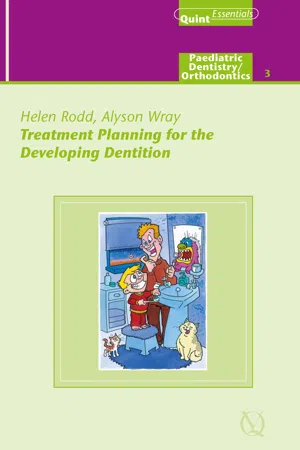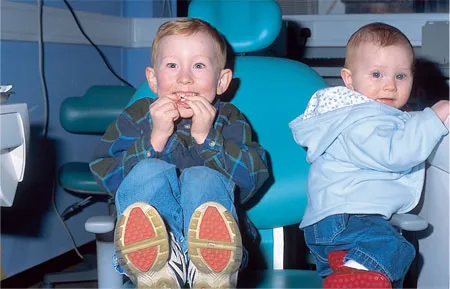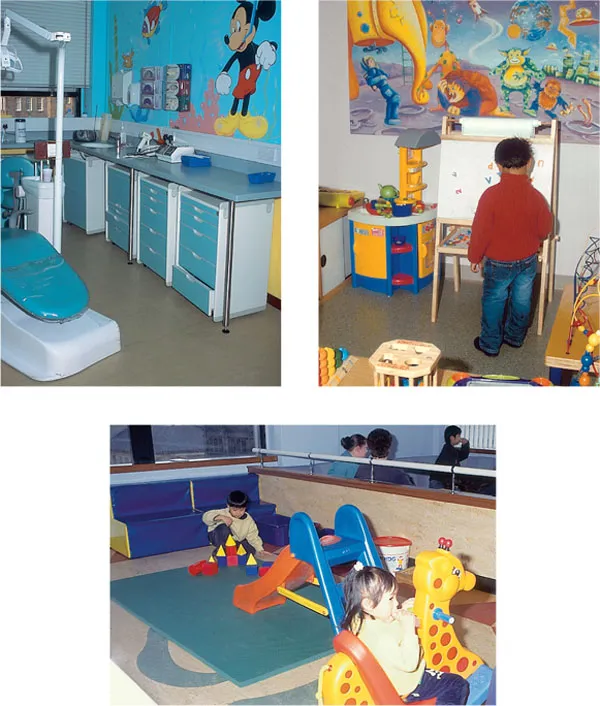
eBook - ePub
Treatment Planning for the Developing Dentition
Alyson P. Wray, Helen D. Rodd
This is a test
- 150 páginas
- English
- ePUB (apto para móviles)
- Disponible en iOS y Android
eBook - ePub
Treatment Planning for the Developing Dentition
Alyson P. Wray, Helen D. Rodd
Detalles del libro
Vista previa del libro
Índice
Citas
Información del libro
This book presents the basic principles underlying sound treatment planning for the young patient, whose early experiences can significantly affect future behavior and attitudes. Treatment planning is not merely a sequence of procedures, but should address the individual social, medical, and dental needs of each child.
Preguntas frecuentes
¿Cómo cancelo mi suscripción?
¿Cómo descargo los libros?
Por el momento, todos nuestros libros ePub adaptables a dispositivos móviles se pueden descargar a través de la aplicación. La mayor parte de nuestros PDF también se puede descargar y ya estamos trabajando para que el resto también sea descargable. Obtén más información aquí.
¿En qué se diferencian los planes de precios?
Ambos planes te permiten acceder por completo a la biblioteca y a todas las funciones de Perlego. Las únicas diferencias son el precio y el período de suscripción: con el plan anual ahorrarás en torno a un 30 % en comparación con 12 meses de un plan mensual.
¿Qué es Perlego?
Somos un servicio de suscripción de libros de texto en línea que te permite acceder a toda una biblioteca en línea por menos de lo que cuesta un libro al mes. Con más de un millón de libros sobre más de 1000 categorías, ¡tenemos todo lo que necesitas! Obtén más información aquí.
¿Perlego ofrece la función de texto a voz?
Busca el símbolo de lectura en voz alta en tu próximo libro para ver si puedes escucharlo. La herramienta de lectura en voz alta lee el texto en voz alta por ti, resaltando el texto a medida que se lee. Puedes pausarla, acelerarla y ralentizarla. Obtén más información aquí.
¿Es Treatment Planning for the Developing Dentition un PDF/ePUB en línea?
Sí, puedes acceder a Treatment Planning for the Developing Dentition de Alyson P. Wray, Helen D. Rodd en formato PDF o ePUB, así como a otros libros populares de Medicine y Dentistry. Tenemos más de un millón de libros disponibles en nuestro catálogo para que explores.
Información
Chapter 1
The First Visit
Aim
In this chapter the importance of introducing a young child to dentistry is emphasised and a strategy for structuring dental treatment is outlined.
Objectives
After reading this chapter the dentist should be able to:
- understand the importance of the child’s early impressions
- plan first visits according to the age of the child
- appreciate the need for a thorough history and clinical examination
- undertake caries risk assessment
- understand the need to initiate a hierarchical treatment plan.
Introduction
Children are the adult dental patients of the future, and good groundwork in the early years of dental monitoring and treatment planning will pay dividends in both the short and long term (Fig 1-1). Furthermore, children are infinitely variable in their behaviour, their development and in their dental needs, and therefore one of the key aims of this book is to establish the importance of individualising treatment planning and dental care.

Fig 1-1 Two pre-school children exploring the dental environment.
There are many reasons why appropriate treatment planning is important – for example, the avoidance of unnecessary treatment such as repeat general anaesthetics or endodontic treatment on a tooth with an unrestorable crown, the facilitation of future interventions, such as retaining roots to maintain alveolar bone, and reduction in stress for operators and patients. It is particularly important with young patients to set easily achievable targets for each visit and for the overall treatment plan. The overall aims of a course of treatment may be very different from those for an adult patient.
First Visit – First Impressions
We are all aware that first impressions can be lasting ones. It is very important that any child’s introduction to dentistry leaves as favourable an impression as possible. This is one of the many reasons why it is so helpful if children begin attending when they have no immediate treatment need. A child who first attends in pain and who may require operative treatment at that visit will have a very different first impression from one who attends symptom-free and only requires a dental examination. For an overview of the approach for a child presenting in pain see Chapter 5.
It is usually beneficial to give children a morning appointment. Although parents may be resistant to this, preferring appointments after school, many young children are tired and hungry at this time of day, and their behaviour is affected accordingly. Seeing young children in the morning, when you are both relatively fresh, is usually more productive.
Wherever possible the practice environment should be child-friendly. Bright decorations, good lighting, simple toys or games in the waiting area go a long way to making a positive first impression. All appointments run late from time to time, but ideally children, in particular anxious ones, should not be kept waiting. If waiting is unavoidable, toys, storybooks and appropriate videos will help to make the wait more pleasant (Fig 1-2).

Fig 1-2 Child-friendly surgery and waiting areas.
Dental practices are very busy places, and it is commonplace for the dentist to stay in the surgery for most of the session and have the dental nurse go to the waiting room to escort the patients to the surgery. This is usually acceptable for adult patients, and those who are very familiar with, and relaxed in, the dental environment. For new, young patients it is much less intimidating if the dentist greets the child in the waiting room, with an accompanying adult close at hand, and then escorts the child into the surgery. Remember that eye contact is very important, in particular at a first meeting. It may be necessary to bend down, or even kneel, to make good eye contact with a small child. Communication involves words (verbal), tone and actions (non-verbal). With children, the verbal component is the least important.
Parent in or out of the Surgery: the Treatment Triangle
Whether or not to have parents in the dental surgery during treatment of their child is an issue most dentists feel quite strongly about. Some advocate always having parents present, others would say never. In reality, it is probably inappropriate to have a hard and fast rule. It is well documented that separation anxiety begins to develop in children around the age of eight or nine months, usually peaks around two to three years of age and for most has dwindled again by the age of five. It would seem reasonable, therefore, to have children accompanied by their parent or carer until the age of three or four, and to make individual decisions about accompaniment from then on (Fig 1-3). A self-confident four-year-old who knows the dentist well will happily sit for a check-up on his or her own. An anxious five-year-old, new to the practice, who needs a first local anaesthetic should, however, have a parent present, provided that the parent has a positive effect on the child’s behaviour.

Fig 1-3 Parental presence is important to reassure very young children in an unfamiliar environment.
It is helpful to establish with the parent that his or her role is to provide support for the child, not to become a communication barrier between the dentist and the patient. An outline of the pros and cons of having parents in the surgery is given in Table 1-1. More detail is given in another volume in this series, Child Taming (see recommended reading).
| Pro | Con |
|
|
The Child is Part of the Family
Before any treatment plan can be drafted, the process of information-gathering must be completed. This can begin even before the first visit, as many children will be part of families already attending the practice. Thus knowledge of the family’s attitude towards dentistry and dental treatment, together with the family history of dental needs, provides a useful base for treatment planning.
Ideally young children should be regular dental attenders as part of family visits from the time of tooth eruption. In reality many children do not attend for dental care until the age of three or four, or until they are experiencing symptoms. Later in this chapter some examples of treatment plans for different age groups are given by way of suggestions for the possible structuring of a series of appointments.
Information Gathering
There are varying opinions regarding the degree of formality appropriate between the dentist and the patient: where children are concerned, it is usually helpful to be informal and to pr...